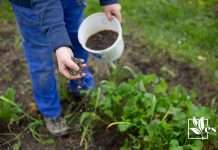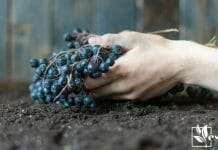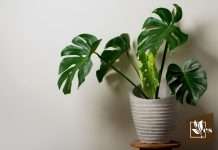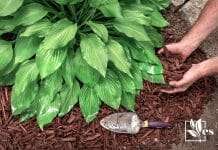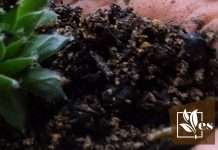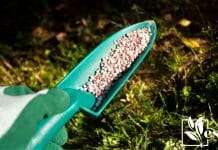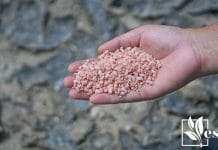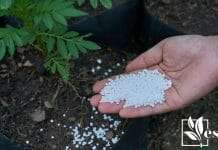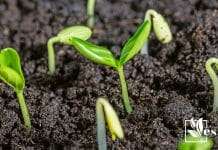Gardening enthusiasts often seek organic options to nourish their plants, and I’ve found that using blood and bone meal is an effective method to improve soil health and plant vitality. These types of fertilizers are cherished for their slow-release properties and their role in providing essential nutrients. As a gardener, it’s crucial to understand the right amount to apply, as over-fertilization can be just as detrimental as a deficiency.

Generally, for blood meal, use 1 to 2 lbs per 100 square feet of soil, depending on the nutrient needs of your plants.
Blood meal, high in nitrogen, is excellent for leafy plants and early season growth. I sprinkle it around the plants in spring, adhering to recommended quantities to avoid nitrogen burn, and repeat every 2 to 3 months during the growing season. Bone meal, rich in phosphorus and calcium, supports the development of strong roots and blooms. I usually incorporate it into the soil around the base of my flowering plants and vegetables, careful to use only small handfuls per square meter to prevent any potential phosphorus build-up in the soil.
It’s not just about quantity but also about timing and method. Organic gardening is about walking in tandem with nature. By gauging the specific needs of my plants and observing their growth responses, I adjust how much and how often I apply these valuable organic amendments to ensure a thriving garden ecosystem.
JUMP TO TOPIC
Optimizing Soil Nutrition and pH
Ensuring that your garden’s soil has the right balance of nutrients and pH is crucial. By understanding soil tests, selecting appropriate fertilizers, and adding organic matter, you can create a fertile environment for your plants to thrive.
Understanding Soil Tests and NPK Ratios
I always start by performing a soil test to determine the levels of nitrogen (N), phosphorus (P), and potassium (K) — together known as NPK — in the soil. This test also reveals the pH level, which affects nutrient availability. My soil’s pH determines which nutrients are available to plants. For instance, bone meal is only effective in soil with a pH below 7.0.
Choosing the Right Fertilizers for Your Garden
I select fertilizers based on the NPK needs of my soil. If nitrogen is low, I use blood meal as it is high in nitrogen (around 13.25%) and can correct deficiencies quickly. Bone meal is used if phosphorus is low, providing a natural source of calcium and phosphorus, essential for root development and blooming.
Improving Soil Structure with Organic Matter
Adding organic matter such as compost or mulch can significantly improve soil structure. This makes it easier for roots to spread, improves water retention, and introduces beneficial microorganisms. I recommend using organic products as soil conditioners to both enrich the soil and boost its nutritional profile.
Here are specific fertilization guidelines for blood meal and bone meal:
For blood meal, use 1 to 2 pounds per 100 square feet of garden. Sprinkle the blood meal around the plants, gently rake it into the soil, and water in well. For bone meal, apply approximately 10 pounds per 100 square feet, and mix it into the soil before planting.
Maximizing Plant Growth and Health
For optimal plant growth, focusing on their nutritional requirements and environmental conditions is key. Each plant variety has specific nutrient needs and light and water preferences that must be balanced for healthy growth.
Essential Nutrients for Root and Foliage Development
To produce strong roots and lush foliage, I make sure the plants get enough essential nutrients. Nitrogen is especially vital as it helps form chlorophyll and is a major component of amino acids, the building blocks of proteins. While applying fertilizers, I use blood meal for a quick nitrogen boost. The recommended amount is 1 to 2 pounds per 100 square feet of garden. I mix it well into the soil to prevent nitrogen burn and for individual plants, a tablespoon around the base should suffice.
💥 Essential Nutrient Mix: 1-2 lbs blood meal/100 sq ft; 1 tbsp around individual plant bases.
The Importance of Watering and Light
Adequate water and light are just as crucial as nutrients. I ensure my plants receive consistent watering, allowing the top inch of soil to dry out between waterings. Overwatering can be as detrimental as underwatering, causing root rot or fungal growth.
Consistent watering is key; allow the top inch of soil to dry out between waterings.
For lighting, I place my plants in conditions that meet their specific needs. Some plants thrive in full sun, while others require partial shade or dappled light. Light intensity affects photosynthesis rates, influences plant morphology, and can dictate the overall success of plant growth.
Ensure plants are placed in their ideal lighting conditions for maximum photosynthesis and growth.
Seasonal Considerations for Garden Maintenance
My approach to garden maintenance involves timely and targeted care, ensuring soil health and optimal growth for vegetables, flowers, and fruits. Each season demands specific actions to maintain a thriving garden.
Spring Planting and Nutrient Management
Spring ushers in planting season. I focus on preparing the soil, enriching it to support the new season’s growth. I follow a schedule for planting seedlings and transplanting them into the garden when the conditions are just right. Consistency in nutrient management, especially with organic materials like blood and bone, is crucial.
Timing: Start seedlings indoors 6-8 weeks before the last frost.
Soil Health: Enrich the soil with compost and a balanced blood and bone application at the recommended rate of about a handful per square meter, mixed thoroughly into the soil.
Preparing the Garden for Summer and Autumn Harvest
As summer approaches, it’s time to prepare my garden for the hot weather and plan for the autumn harvest. Care includes frequent monitoring for pests and diseases, ensuring adequate water supply, and providing shade when needed. I maintain a monthly fertilizer routine to replenish nutrients.
- Mulch beds to retain moisture and control temperature.
- Harvest fruits and vegetables as they ripen.
- Prune fruit-bearing shrubs post-fruiting.
- Keep an eye out for insects, using natural predators or organic sprays as needed.
I adhere to a disciplined approach, ensuring that my garden not only survives but thrives throughout the changing seasons. By doing so, my plants remain robust, and the harvest is fruitful.
Safety and Environmental Concerns in Organic Gardening
As an avid organic gardener, I’m always careful to balance the health of my plants with the well-being of the environment and local fauna. Ensuring we use organic products like blood and bone responsibly is critical to protect our gardens, pets, wildlife, and ourselves from unintentional harm.
Preventing Pet and Wildlife Hazards
Pets and wildlife may be attracted to bone meal and blood meal fertilizers. Dogs, in particular, find these products enticing and may ingest large quantities, which could lead to pancreatitis or form a concretion in the stomach.
Always store blood and bone away from pets and apply it according to the instructions, ensuring it’s well mixed with the soil, which can help in reducing the risk to pets and wildlife.
Mitigating the Risks of Pathogens and Pollution
Organic fertilizers can carry pathogens if not processed correctly, potentially leading to illness in humans and animals. To ensure safety, I use certified products and apply them correctly. Moreover, runoff from excessive fertilizer can lead to pollution in waterways. Thus, caution is advised when applying fertilizers before a heavy rain or on slopes.
I ensure to use these fertilizers judiciously, only as much as my plants need, to prevent nutrient runoff that could harm our waterways. This approach aligns with the safety considerations essential to organic gardening, demonstrating care for our environment.



